Nationality American | Name George Foreman Reach 82 in (208 cm) Height 1.92 m | |
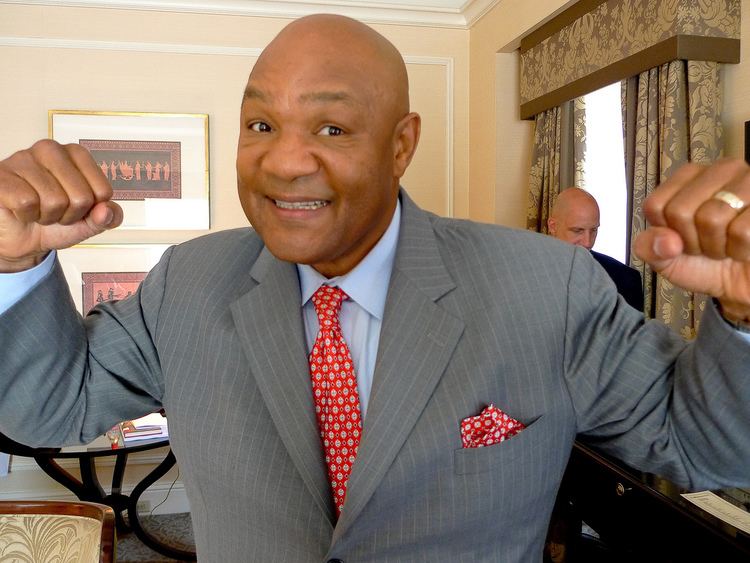 | ||
Role Professional Boxer · georgeforeman.com Children Freeda Foreman, George Foreman III, Natalia Foreman Spouse Mary Joan Martelly (m. 1985) Books The Next Grilleration Movies and TV shows The Fighter, Family Foreman, George, Play It to the Bone, American Inventor Similar People | ||
Foreman on Ali: Boxing 'Will Never Be the Same'
George Edward Foreman (born January 10, 1949) is an American former professional boxer who competed from 1969 to 1977, and from 1987 to 1997. Nicknamed "Big George", he is a two-time world heavyweight champion and an Olympic gold medalist. Outside the sport he is an ordained minister, author, and entrepreneur.
Contents
- Foreman on Ali Boxing Will Never Be the Same
- Top 10 george foreman best knockouts hd
- Early life and amateur career
- 1968 Summer Olympics
- Amateur accomplishments
- Professional career
- Sunshine Showdown Foreman vs Frazier
- Foreman vs Norton
- The Rumble in the Jungle Foreman vs Ali
- First comeback
- Retirement and spiritual rebirth
- Second comeback
- Foreman vs Cooney
- Foreman vs Holyfield
- Foreman vs Morrison
- Regaining the title Foreman vs Moorer
- Foreman vs Schulz
- Losing the title Foreman vs Briggs
- Second and final retirement
- Personal life
- George Foreman Grill
- References

After a troubled childhood, Foreman took up amateur boxing and won a gold medal in the heavyweight division at the 1968 Summer Olympics. Having turned professional the next year, he won the world heavyweight title with a second-round knockout of then-undefeated Joe Frazier in 1973. Two successful title defenses were made before Foreman's first professional loss to Muhammad Ali in "The Rumble in the Jungle" in 1974. Unable to secure another title opportunity, Foreman retired after a loss to Jimmy Young in 1977.
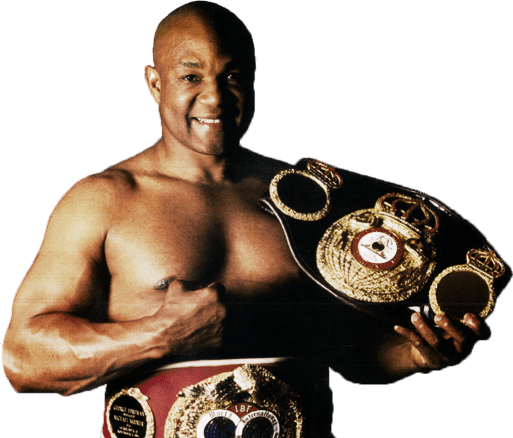
Following what he referred to as a religious epiphany, Foreman became an ordained Christian minister. Ten years later he announced a comeback and, in 1994, at age 45, he regained a portion of the heavyweight championship by knocking out 27-year-old Michael Moorer to win the unified WBA, IBF, and lineal titles. Foreman remains the oldest world heavyweight champion in history, and the second oldest in any weight class after Bernard Hopkins (at light heavyweight). He retired in 1997 at the age of 48, with a final record of 76 wins (68 knockouts) and 5 losses.

Foreman has been inducted into the World Boxing Hall of Fame and International Boxing Hall of Fame. The International Boxing Research Organization rates Foreman as the eighth greatest heavyweight of all time. In 2002, he was named one of the 25 greatest fighters of the past 80 years by The Ring magazine. The Ring ranked him as the ninth greatest puncher of all time. He was a ringside analyst for HBO's boxing coverage for twelve years until 2004. Outside of boxing, he is a successful entrepreneur and known for his promotion of the George Foreman Grill, which has sold over 100 million units worldwide. In 1999, he sold the naming rights to the grill for $138 million.

Top 10 george foreman best knockouts hd
Early life and amateur career
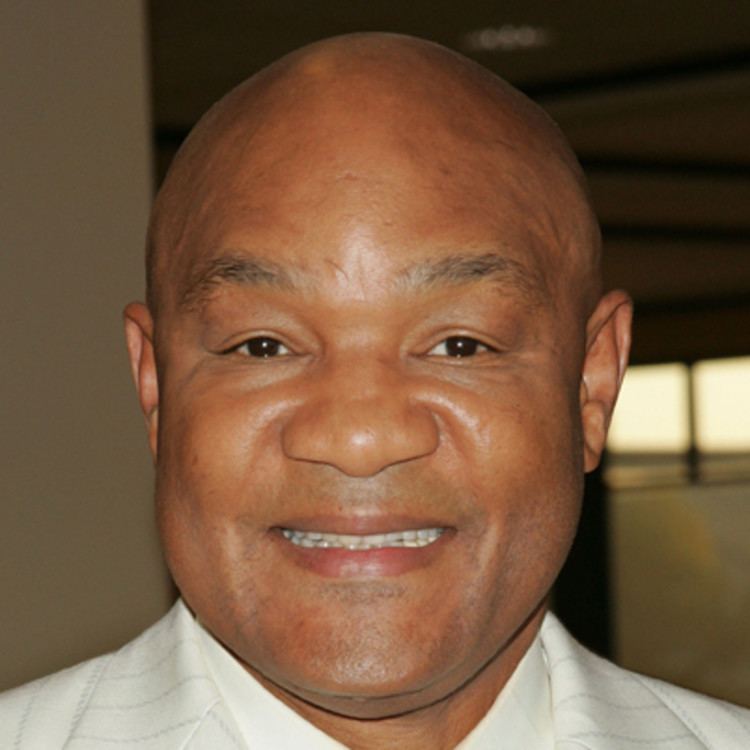
George Foreman was born in Marshall, Texas. He grew up in the Fifth Ward, Houston, with six siblings. Although he was raised by J. D. Foreman, whom his mother had married when George was a small child, his biological father was Leroy Moorehead. By his own admission in his autobiography, George was a troubled youth. He dropped out of school at the age of fifteen and later joined the Job Corps. After moving to Pleasanton, California, with the help of a supervisor he began to train in boxing. Foreman was interested in football and idolized Jim Brown, but gave it up for boxing.
1968 Summer Olympics
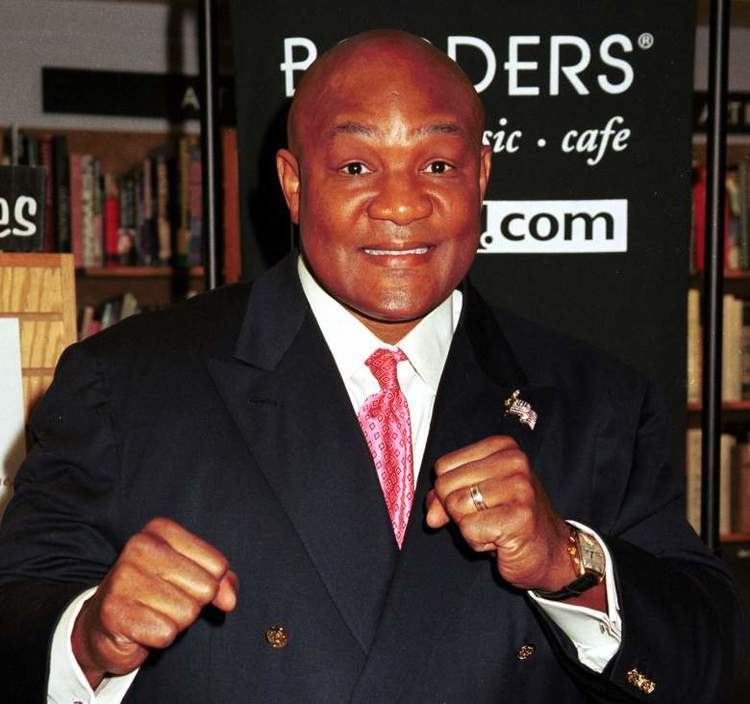
Foreman won a gold medal in the boxing/heavyweight division at the 1968 Mexico City Olympic Games. In the final Olympic bout, Foreman defeated Soviet Union's Jonas Čepulis when the referee stopped the fight in the 2nd round. Čepulis' face was already bleeding in the first round from Foreman's punches, and had to take a standing eight count early in the second round. After winning the gold medal fight, Foreman walked around the ring carrying a small U.S. flag.
Amateur accomplishments
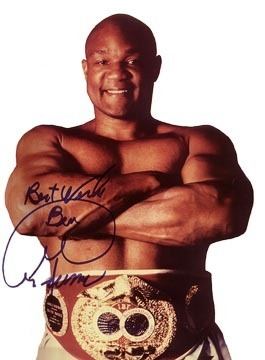
Professional career
Foreman turned professional in 1969 with a three-round knockout of Donald Walheim in New York. He had a total of 13 fights that year, winning all of them (11 by knockout).
In 1970, Foreman continued his march toward the undisputed heavyweight title, winning all 12 of his bouts (11 by knockout). Among the opponents he defeated were Gregorio Peralta, whom he decisioned at Madison Square Garden although Peralta showed that Foreman was vulnerable to fast counter punching mixed with an assertive boxing style. Foreman then defeated George Chuvalo by technical knockout (TKO) in three rounds. After this win, Foreman defeated Charlie Polite in four rounds and Boone Kirkman in three.
In 1971, Foreman won seven more fights, winning all of them by knockout, including a rematch with Peralta, whom he defeated by knockout in the tenth and final round in Oakland, California, and a win over Leroy Caldwell, who was knocked out in the second round. After amassing a record of 32–0 (29 KO), he was ranked as the number one challenger by the WBA and WBC.
Sunshine Showdown: Foreman vs. Frazier
In 1972, still undefeated and with an impressive knockout record, Foreman was set to challenge undefeated and Undisputed World Heavyweight Champion Joe Frazier. Despite boycotting a title elimination caused by the vacancy resulting from the championship being stripped from Muhammad Ali, Frazier had won the title from Jimmy Ellis and defended his title four times since, including a 15-round unanimous decision over the previously unbeaten Ali in 1971 after Ali had beaten Oscar Bonavena and Jerry Quarry. Despite Foreman's superior size and reach, he was not expected to beat Frazier and was a 3:1 underdog going into the fight.
The Sunshine Showdown took place on January 22, 1973, in Kingston, Jamaica, with Foreman dominating the fight to win the championship by technical knockout. In ABC's re-broadcast, Howard Cosell made the memorable call, "Down goes Frazier! Down goes Frazier! Down goes Frazier!" Before the fight Frazier was 29–0 (25 KO) and Foreman was 37–0 (34 KO). Frazier was knocked down six times by Foreman within two rounds (the three-knockdown rule was not in effect for this bout). After the second knockdown, Frazier's balance and mobility were impaired to the extent that he was unable to evade Foreman's combinations. Frazier managed to get to his feet for all six knockdowns, but referee Arthur Mercante eventually called an end to the one-sided bout.
Foreman was sometimes characterized by the media as an aloof and antisocial champion. According to them, he always seemed to wear a sneer and was not often available to the press. Foreman later attributed his demeanor during this time as an emulation of Sonny Liston, for whom he had been an occasional sparring partner. Foreman defended his title successfully twice during his initial reign as champion. His first defense, in Tokyo, pitted him against Puerto Rican Heavyweight Champion José Roman. Roman was not regarded as a top contender, and it took Foreman only 2 minutes to end the fight, one of the fastest knockouts in a Heavyweight Championship bout.
Foreman vs. Norton
Foreman's next defense was against a much tougher opponent. In 1974, in Caracas, Venezuela, he faced the highly regarded future hall-of-famer Ken Norton (who was 30–2), a boxer noted for his awkward crossed-arm boxing style, crab-like defense, and heavy punch (a style Foreman emulated in his comeback), who had broken the jaw of Muhammad Ali in a points victory a year earlier. Norton had a good chin and had performed well against Ali in their two matches, winning the first on points and nearly winning the second. (Norton developed a reputation for showing nerves against heavy hitters, largely beginning with this fight.) After an even first round, Foreman staggered Norton with an uppercut a minute into round two, buckling him into the ropes. Norton did not hit the canvas but continued on wobbly legs, clearly not having recovered, and shortly he went down a further two times in quick succession, with the referee intervening and stopping the fight. "Ken was awesome when he got going. I didn't want him to get into the fight", Foreman said when interviewed years later. This fight became known as the "Caracas Caper".
Foreman had cruised past two of the top names in the rankings. The win gave him a 40–0 record with 37 knockouts.
The Rumble in the Jungle: Foreman vs. Ali
Foreman's next title defence, against Muhammad Ali, was historic. During the summer of 1974, he traveled to Zaire (now the Democratic Republic of the Congo) to defend his title against Ali. The bout was promoted as "The Rumble in the Jungle".
During training in Zaire, Foreman suffered a cut above his eye, forcing postponement of the match for a month. The injury affected his training regimen, as it meant he could not spar in the build-up to the fight and risk the cut being re-opened. He later commented: "That was the best thing that happened to Ali when we were in Africa—the fact that I had to get ready for the fight without being able to box." Foreman later also claimed he was drugged by his trainer prior to the bout. Ali used this time to tour Zaire, endearing himself to the public while taunting Foreman at every opportunity. Foreman was favored, having knocked out both Joe Frazier and Ken Norton within two rounds.
When Foreman and Ali finally met in the ring, Ali began more aggressively than expected, outscoring Foreman with superior punching speed. However, Ali quickly realized that this approach required him to move much more than Foreman and would cause him to tire. In the second round, Ali retreated to the ropes, shielding his head and hitting Foreman in the face at every opportunity. Foreman dug vicious body punches into Ali's sides; however, Foreman was unable to land many big punches to Ali's head. The ring ropes, being much looser than usual (Foreman later charged that Angelo Dundee had loosened them, and this story is supported by Norman Mailer in the book The Fight), allowed Ali to lean back and away from Foreman's wild swings and then grab Foreman behind the head, forcing Foreman to expend much extra energy untangling himself. Ali also constantly pushed down on Foreman's neck but was never warned about doing so. To this day, it is unclear whether Ali's pre-fight talk of using speed and movement against Foreman had been just a diversionary tactic or whether his use of what became known as the "rope-a-dope" tactic was an improvisation necessitated by Foreman's constant pressure.
In either case, Ali was able to occasionally counter off the ropes with blows to the face and penetrated Foreman's defense. Ali continued to take heavy punishment to the body and occasionally a hard jolt to the head. Ali later said he was "out on his feet" twice during the bout. Eventually, Foreman began to tire, and his punches became increasingly wild, losing power in the process. An increasingly confident Ali taunted Foreman throughout the bout. Late in the eighth round, Foreman was left off balance by a haymaker, and Ali sprang off the ropes with a flurry to Foreman's head, punctuated by a hard right cross that landed flush on the jaw, knocking Foreman down. Muhammad Ali was the first boxer to stop Foreman.
Foreman later reflected that "it just wasn't my night". Though he sought one, he was unable to secure a rematch with Ali. It has been suggested in some quarters that Ali was ducking Foreman, although he did give a rematch to Joe Frazier and to Ken Norton. Ali also preferred to fight such "minimal risk" opponents as Chuck Wepner, Richard Dunn, Jean Pierre Coopman, and Alfredo Evangelista.
First comeback
Foreman remained inactive during 1975. In 1976, he announced a comeback and stated his intention of securing a rematch with Ali. His first opponent was to be Ron Lyle, who had been defeated by Muhammad Ali in 1975, via 11-th round TKO. At the end of the first round, Lyle landed a hard right that sent Foreman staggering across the ring. In the second round, Foreman pounded Lyle against the ropes and might have scored a KO, but due to a timekeeping error the bell rang with a minute still remaining in the round and Lyle survived. In the third, Foreman pressed forward, with Lyle waiting to counter off the ropes. In the fourth, a brutal slugfest erupted. A cluster of power punches from Lyle sent Foreman to the canvas. When Foreman got up, Lyle staggered him again, but just as Foreman seemed finished, he retaliated with a hard right to the side of the head, knocking down Lyle. Lyle beat the count, then landed another brutal combination, knocking Foreman down for the second time. Again, Foreman beat the count. Foreman said later that he had never been hit so hard in a fight and remembered looking down at the canvas and seeing blood. In the fifth round, both fighters continued to ignore defense and traded their hardest punches, looking crude. Each man staggered the other, and each seemed almost out on his feet. Then, as if finally tired, Lyle stopped punching, and Foreman delivered a dozen unanswered blows until Lyle collapsed. Lyle remained on the canvas and was counted out, giving Foreman the KO victory. The fight was named by The Ring as "The Fight of the Year."
For his next bout, Foreman chose to face Joe Frazier in a rematch. Because of the one-sided Foreman victory in their first fight, and the fact that Frazier had taken a tremendous amount of punishment from Ali in Manila a year earlier, few expected him to win. Frazier at this point was 32–3, and Foreman was 41–1. However, the 2nd Foreman-Frazier fight was fairly competitive for its duration, as Frazier used quick head movements to make Foreman miss with his hardest punches. Frazier was wearing a contact lens for his vision which was knocked loose during the bout. After being unable to mount a significant offense, Frazier was eventually floored twice by Foreman in the fifth round and the fight was stopped. Next, Foreman knocked out Scott LeDoux in three rounds and prospect John Dino Denis in four to finish the year.
Retirement and spiritual rebirth
1977 proved to be a life changing year for Foreman. After knocking out Pedro Agosto in four rounds at Pensacola, Florida, Foreman flew to Puerto Rico a day before the fight without giving himself time to acclimatise. His opponent was the skilled boxer Jimmy Young, who had beaten Ron Lyle and lost a very controversial decision to Muhammad Ali the previous year. Foreman fought cautiously early on, allowing Young to settle into the fight. Young constantly complained about Foreman pushing him, for which Foreman eventually had a point deducted by the referee, although Young was never warned for his persistent holding. Foreman badly hurt Young in round 7 but was unable to land a finishing blow. Foreman tired during the second half of the fight and suffered a knockdown in round 12 en route to losing a decision.
Foreman became ill in his dressing room after the fight. He was suffering from exhaustion and heatstroke and stated he had a near-death experience. He spoke of being in a hellish, frightening place of nothingness and despair, and realized that he was in the midst of death. Though not yet religious, he began to plead with God to help him. He explained that he sensed God asking him to change his life and ways. When he said, "I don't care if this is death – I still believe there is a God", he felt a hand pull him out and sensed that he was also suffering stigmata. After this experience, Foreman became a born-again Christian, dedicating his life for the next decade to God. Although he did not formally retire from boxing, Foreman stopped fighting and became an ordained minister, initially preaching on street corners before becoming the reverend at the Church of the Lord Jesus Christ in Houston and devoting himself to his family and his congregation. He also opened a youth center that bears his name. Foreman continues to share his conversion experience on Christian television broadcasts such as The 700 Club and the Trinity Broadcasting Network and later joked that Young had knocked the devil out of him.
Second comeback
In 1987, after 10 years away from the ring, Foreman surprised the boxing world by announcing a comeback at the age of 38. In his autobiography, he wrote that his primary motive was to raise money to fund the youth center he had created, which had required much of the money he had earned in the initial phase of his career. Another stated ambition was to fight Mike Tyson. For his first fight, he went to Sacramento, California, where he beat journeyman Steve Zouski by a knockout in four rounds. Foreman weighed 267 lb (121 kg) for the fight and looked badly out of shape. Although many thought his decision to return to the ring was a mistake, Foreman countered that he had returned to prove that age was not a barrier to people achieving their goals (as he said later, he wanted to show that age 40 is not a "death sentence"). He won four more bouts that year, gradually slimming down and improving his fitness. In 1988, he won nine times. Perhaps his most notable win during this period was a seventh-round knockout of former Light Heavyweight and Cruiserweight Champion Dwight Muhammad Qawi.
Having always been a deliberate fighter, Foreman had not lost much mobility in the ring since his first "retirement", although he found it harder to keep his balance after throwing big punches and could no longer throw rapid combinations. He was still capable of landing heavy single blows, however. The late-round fatigue that had plagued him in the ring as a young man now seemed to be unexpectedly gone, and he could comfortably compete for 12 rounds. Foreman attributed this to his new, relaxed fighting style (he has spoken of how, earlier in his career, his lack of stamina came from an enormous amount of nervous tension).
By 1989, while continuing his comeback, Foreman had sold his name and face for the advertising of various products, selling everything from grills to mufflers on TV. For this purpose his public persona was reinvented, and the formerly aloof, ominous Foreman had been replaced by a smiling, friendly George. He and Ali had become friends, and he followed in Ali's footsteps by making himself a celebrity outside the boundaries of boxing.
Foreman continued his string of victories, winning five more fights, the most impressive being a three-round win over Bert Cooper, who went on to contest the Undisputed Heavyweight title against Evander Holyfield.
Foreman vs. Cooney
In 1990, Foreman met former title challenger Gerry Cooney in Atlantic City. Cooney was coming off a long period of inactivity, but was well regarded for his punching power. Cooney wobbled Foreman in the first round, but Foreman landed several powerful punches in the second round. Cooney was knocked down twice and Foreman had scored a devastating KO. Foreman went on to win four more fights that year.
Foreman vs. Holyfield
The following year, Foreman was given the opportunity to challenge undisputed heavyweight champion Evander Holyfield, who was in tremendous shape at 208 pounds, for the world title in a pay-per-view boxing event. Very few boxing experts gave the 42-year-old Foreman a chance of winning. Foreman, who weighed in at 257 pounds, began the contest by marching forward, absorbing several of Holyfield's best combinations and occasionally landing a powerful swing of his own. Holyfield proved too tough and agile to knock down and was well ahead on points throughout the fight, but Foreman surprised many by lasting the full 12 rounds, losing his challenge on points. Round 7, in which Foreman knocked Holyfield off balance before being staggered by a powerful combination, was expected to be Ring Magazine's "Round of the Year", though no award was given in 1991.
A year later, Foreman fought journeyman Alex Stewart, who had previously been stopped in the first round by Mike Tyson. Foreman knocked down Stewart twice in the second round but expended a lot of energy in doing so. He subsequently tired, and Stewart rebounded. By the end of the 10th and final round, Foreman's face was bloodied and swollen, but the judges awarded him a majority decision win.
Foreman vs. Morrison
In 1993, Foreman received another title shot, although this was for the vacant WBO title, which most boxing experts at the time viewed as a second-tier version of the "real" heavyweight title, then being contested between Holyfield and Riddick Bowe. Foreman's opponent was Tommy Morrison, a young prospect known for his punching power. To the frustration of Foreman and the disappointment of the booing crowd, Morrison retreated throughout the fight, refusing to trade toe-to-toe, and sometimes even turned his back on Foreman. The strategy paid off, however, as he outboxed Foreman from long range. Foreman was competitive throughout the match, but after 12 rounds, Morrison won a unanimous decision.
In this period, Foreman also starred briefly in the situation comedy "George" on ABC. The show, which featured Foreman as a retired boxer, premiered in November, 1993, and ran for ten episodes where nine aired. The show was co-produced by actor and former boxer Tony Danza.
Regaining the title: Foreman vs. Moorer
In 1994, Foreman again sought to challenge for the world championship after Michael Moorer had beaten Holyfield for the IBF and WBA titles.
Having lost his last fight against Morrison, Foreman was unranked and in no position to demand another title shot. His relatively high profile, however, made a title shot against Moorer, 19 years his junior, a lucrative prospect at seemingly little risk for the champion.
Foreman's title challenge against Moorer took place on November 5 in Las Vegas, Nevada, with Foreman wearing the same red trunks he had worn in his title loss to Ali 20 years earlier. This time, however, Foreman was a substantial underdog. For nine rounds, Moorer easily outboxed him, hitting and moving away, while Foreman chugged forward, seemingly unable to "pull the trigger" on his punches. Entering the tenth round, Foreman was trailing on all scorecards. However, Foreman launched a comeback in the tenth round and hit Moorer with a number of punches. Then a short right hand caught Moorer on the tip of his chin, gashing open his bottom lip and he collapsed to the canvas. He lay flat on the canvas as the referee counted him out.
In an instant, Foreman had regained the title he had lost to Muhammad Ali two decades before. He went back to his corner and knelt in prayer as the arena erupted in cheers. With this historic victory, Foreman broke three records: he became, at age 45, the oldest fighter ever to win the World Heavyweight Championship; 20 years after losing his title for the first time, he broke the record for the fighter with the longest interval between his first and second world championships; and the age spread of 19 years between the champion and challenger was the largest of any heavyweight boxing championship fight.
Foreman vs. Schulz
Shortly after the Moorer fight, Foreman began talking about a potential superfight against Mike Tyson (the youngest ever heavyweight champ). The WBA organization, however, demanded he fight their No. 1 challenger, who at the time was the competent but aging Tony Tucker. For reasons not clearly known, Foreman refused to fight Tucker and allowed the WBA to strip him of that belt. He then went on to fight mid-level prospect Axel Schulz of Germany in defense of his remaining IBF title. Schulz was a major underdog. Schulz jabbed strongly from long range and grew increasingly confident as the fight progressed. Foreman finished the fight with a swelling over one eye, but was awarded a controversial majority decision. The IBF ordered an immediate rematch to be held in Germany, but Foreman refused the terms and found himself stripped of his remaining title. However, Foreman continued to be recognized as the Lineal Heavyweight Champion.
Losing the title: Foreman vs. Briggs
In 1996, Foreman returned to Tokyo, scoring an easy win over the unrated Crawford Grimsley by a 12-round decision. In 1997, he faced contender Lou Savarese, winning a close decision in a grueling, competitive encounter. Then, yet another opportunity came Foreman's way as the WBC decided to match him against Shannon Briggs in a 1997 "eliminator bout" for the right to face WBC champion Lennox Lewis. After 12 rounds, in which Foreman consistently rocked Briggs with power punches, almost everyone at ringside saw Foreman as the clear winner. Once again there was a controversial decision—but this time it went in favor of Foreman's opponent, with Briggs awarded a points win (114–114, 116–112, and 117–113). Foreman had fought for the last time, at the age of 48.
Second and final retirement
Foreman was gracious and philosophical in his loss to Briggs, but announced his "final" retirement shortly afterwards. However, he did plan a return bout against Larry Holmes in 1999, scheduled to take place at the Houston Astrodome on pay per view. The fight was to be billed as "The Birthday Bash" due to both fighters' upcoming birthdays. Foreman was set to make $10 million and Holmes was to make $4 million, but negotiations fell through and the fight was cancelled. With a continuing affinity for the sport, Foreman became a respected boxing analyst for HBO.
Foreman said he had no plans to resume his career as a boxer, but then announced in February 2004 that he was training for one more comeback fight to demonstrate that the age of 55, like 40, is not a "death sentence." The bout, against an unspecified opponent (rumored to be Trevor Berbick), never materialized (it was widely thought that Foreman's wife had been a major factor in the change of plans). George Foreman left the sport of boxing after leaving HBO to pursue other opportunities.
Personal life
Foreman has been married to Mary Joan Martelly since 1985, prior to that, he was married four times. He was wed to Adrienne Calhoun from 1971-1974, Cynthia Lewis from 1977 to 1979, Sharon Goodson from 1981 to 1982, and Andrea Skeete from 1982 to 1985.
Foreman has 12 children, five sons and seven daughters. His five sons are George Jr., George III ("Monk"), George IV ("Big Wheel"), George V ("Red"), and George VI ("Little Joey"). On his website, Foreman explains, "I named all my sons George Edward Foreman so they would always have something in common. I say to them, "If one of us goes up, then we all go up together, and if one goes down, we all go down together!" As with his father, George III has pursued a career in boxing and entrepreneurship. George IV appeared on the second season of American Grit, where he placed seventh.
The two daughters from his marriage are Natalia and Leola; his three daughters from a separate relationship are Michi, Freeda, and Georgetta. He adopted a daughter, Isabella Brandie Lilja (Foreman), in 2009; and another, Courtney Isaac (Foreman), in 2012.
In recognition of Foreman's patriotism and community service, The American Legion honored him with their James V. Day "Good Guy" Award during their 95th National Convention in 2013.
George Foreman Grill
When Foreman came back from retirement he argued that his success was due to his healthy eating, which made him a perfect fit for Salton, Inc., which was looking for a spokesperson for its fat-reducing grill, in which Foreman had some influence designing. Hulk Hogan had previously been considered, but chose to pitch the Hulkamania Meatball Maker instead. As of 2009, the George Foreman Grill has sold over 100 million units since it was first launched, a feat achieved in a little over 15 years.
Although Foreman has never confirmed exactly how much he has earned from the endorsement, it is known that Salton paid him $138 million in 1999, for the right to use his name. Prior to that, he was paid about 40% of the profits on each grill sold (earning him $4.5 million a month in payouts at its peak), so it is estimated he has made a total of over $200 million from the endorsement, substantially more than he earned as a boxer. Recently, Foreman has capitalized on the success obtained with the Foreman Grill to endorse InventHelp; the company behind INPEX (Invention and New Product Exposition); America's largest invention trade show.
